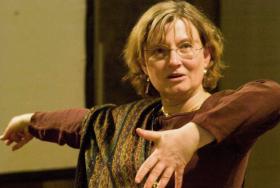
Ingrid Daubechies is eager to help Duke scientists throw a few life-preservers to the science community which, she says, is now "drowning in data."
Daubechies (pronounced DOHB-shee), who joins Duke's mathematics faculty in January 2011, is one of the world's authorities on sorting through complex data sets to find hidden meaning.
Because technology has created so many methods to collect information, researchers need new tools to tease out only the data essential to their studies, Daubechies explains. She is already looking to join forces with a few scientists in the electrical and computer engineering department on this type of research.
"It's been said that Ingrid is the world's most famous female mathematician," says Harold Layton, chair of the mathematics department. "She's full of energy, has a wonderful personality and rapport with students and her fellow colleagues, and we are delighted to have her."
Daubechies is best known for developing a particular type of mathematical concept called wavelets, making her a leader in the field of signal processing, a branch of applied mathematics that is concerned with transmitting, analyzing, manipulating, reconstructing and storing signals.
A signal is a squiggly line like those in seismological graphs of earthquakes or an endocardiogram of the heart, and can come from a distant star or a musical instrument. Signal processing is trying to tease out the star's signal from a jumble of other cosmic noise or to isolate a single note from the cacophony of sounds in an orchestra.
The challenge of signal processing is a dichotomy between timing and frequency. Daubechies likens the problem to that of a physicist who knows the exact position of a particle, but cannot simultaneously know the particle's speed. Similarly, a digital signal processor analyzing a musical note has difficulty extracting information on the exact frequency, or pitch, of a signal and the exact moment it was played.
Sheet music, of course, tells the musician the exact note to play at the exact moment it is to be played, she says. The series of notes represent an ancient short-hand of signals that signal-processors have tried to recreate in the technological realm.Daubechies was one of the first to create the technological equivalent of sheet music for signal processing. She did this by expanding on another mathematical concept, called Fourier analysis, which can decipher a signal's frequency or timing, but not both within the same signal analysis. The solution lay in a specific type of tiny waves, called wavelets, where the length of each wavelet is mathematically related to the pitch it represents.
With Daubechies' wavelets, a higher pitch corresponds to a briefer wavelet. The crash of a cymbal, for example, has a lot of high-frequency elements. Its wavelets are short. Middle C, however, has a single, mid-toned element and has longer wavelets. Because of the mathematical relationship between frequency and wavelet size, it's possible to simultaneously determine the instant a signal is produced and its given frequency.
Daubechies looks forward to applying her wavelet constructs and other mathematical constructs at Duke to find "new and better ways to deal with data," particularly information related to animal movement and biological tissue chemistry.
As the recently elected president of the International Mathematical Union and as a 2010 Guggenheim Fellow, Daubechies also will dedicate part of her time to improving math education at the secondary level and within developing countries. Her first project is to design the mathematics curriculum for improving Madagascar's science and technology sector, which focuses heavily on the country's environment.
A native of Belgium, Daubechies earned her Ph.D. in physics in 1980 from the Free University of Brussels and taught there for 12 years before she joined AT&T Bell Laboratories. There, she became a leading expert on wavelet theory and developed her own type of wavelets in 1987. Since 1993, she has been a full professor in the Program in Applied and Computational Mathematics at Princeton University.
Daubechies is married to mathematician and computer scientist Robert Calderbank, the recently appointed Dean of Natural Sciences at Duke. They have two children, both interested in becoming math educators.